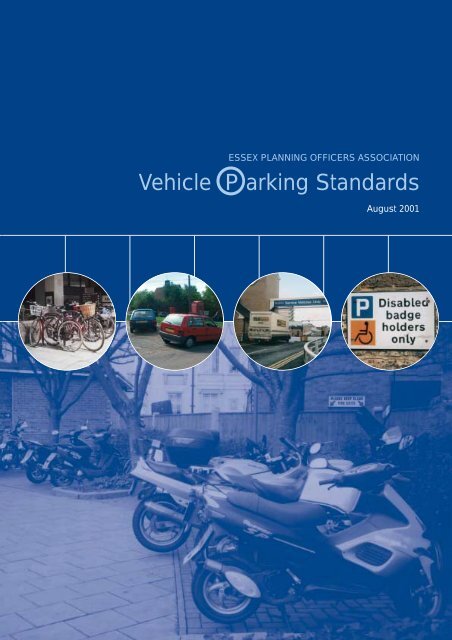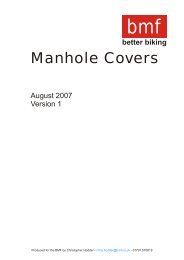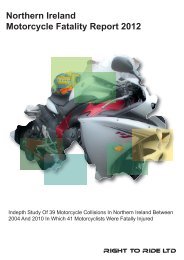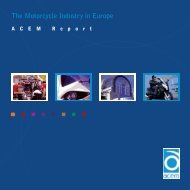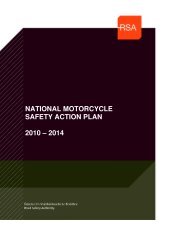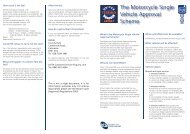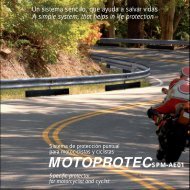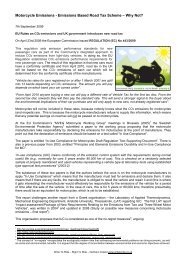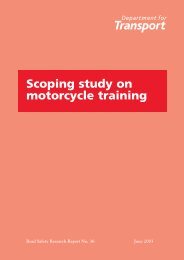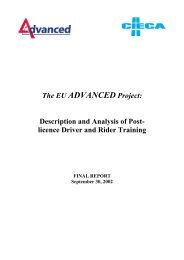Vehicle Parking Standards - Southend-on-Sea Borough Council
Vehicle Parking Standards - Southend-on-Sea Borough Council
Vehicle Parking Standards - Southend-on-Sea Borough Council
- No tags were found...
Create successful ePaper yourself
Turn your PDF publications into a flip-book with our unique Google optimized e-Paper software.
ESSEX PLANNING OFFICERS ASSOCIATION<str<strong>on</strong>g>Vehicle</str<strong>on</strong>g> P arking <str<strong>on</strong>g>Standards</str<strong>on</strong>g>August 2001
ESSEX PLANNING OFFICERS ASSOCIATION<str<strong>on</strong>g>Vehicle</str<strong>on</strong>g> P arking <str<strong>on</strong>g>Standards</str<strong>on</strong>g>August 2001FOREWORDThe provisi<strong>on</strong> of car parking is an important area of developmentc<strong>on</strong>trol and a key tool in promoting sustainable transport.Previous standards for car parking were produced byEssex County <strong>Council</strong> in 1987 for the then County of Essex.These standards were produced <strong>on</strong> the basis of a minimumrequirement, with any shortfalls being balanced through‘commuted payments’ made to the relevant local authorityto c<strong>on</strong>tribute to public transport infrastructure and services.The publicati<strong>on</strong> of the Transport White Paper "A New DealFor Transport: Better For Every<strong>on</strong>e" in 1998 represented asignificant point of change for transport policy and planning.Local authorities are expected to promote sustainabilitythrough encouraging modal shift and the use of alternativeforms of travel to the car, mainly public transport, walkingand cycling. Adopting the principle of maximum parkingstandards is a means of promoting sustainable development.Whereas previous parking guidance for Essex advocateda minimum benchmark for the number of spaces permitted,the new standards set a maximum limit <strong>on</strong> the number ofspaces provided.This approach is in accordance with Regi<strong>on</strong>al PlanningGuidance for the South East (RPG9) which was adopted inMarch 2001 and Planning Policy Guidance (PPG) publishedby the Government, including;- PPG3 – Housing (March 2000), and- PPG13 – Transport (March 2001).The main standards are specifically for the parking of cars,but it is emphasised in the document that separate additi<strong>on</strong>alprovisi<strong>on</strong> at an appropriate level should be made for servicevehicles delivering goods to any development or operatingfrom that development. <str<strong>on</strong>g>Standards</str<strong>on</strong>g> for the parking of cyclesand motorcycles are included separately. It should be notedthat these standards represent minimum permitted provisi<strong>on</strong>,rather than maximum, reflecting the sustainable nature ofthese travel modes. Guidance for the provisi<strong>on</strong> of parkingfor people with disabilities, in accordance with the DisabilityDiscriminati<strong>on</strong> Act 1996, is included in Appendix 2.<str<strong>on</strong>g>Standards</str<strong>on</strong>g> For <str<strong>on</strong>g>Vehicle</str<strong>on</strong>g> <str<strong>on</strong>g>Parking</str<strong>on</strong>g> In EssexAdvisory parking standards for development in Essex,<str<strong>on</strong>g>Southend</str<strong>on</strong>g>-<strong>on</strong>-<strong>Sea</strong> and Thurrock. The standards arecommended for adopti<strong>on</strong> as Supplementary PlanningGuidance. Thurrock <strong>Council</strong> may also wish to c<strong>on</strong>sideradopti<strong>on</strong> of the standards in relati<strong>on</strong> to the ThurrockUnitary Development Plan.To take account of this change in policy, the Essex PlanningOfficers Associati<strong>on</strong> appointed a working party to undertakea review of parking standards with the objective of developingmaximum standards and promoting sustainable travel patterns.These standards are c<strong>on</strong>tained within this document. Detailsof the compositi<strong>on</strong> and terms of reference of the working partyare provided <strong>on</strong> page 2.The Essex and <str<strong>on</strong>g>Southend</str<strong>on</strong>g> <strong>on</strong> <strong>Sea</strong> Replacement StructurePlan provides for the introducti<strong>on</strong> of maximum standardsin accordance with Government guidance to be issuedas Supplementary Planning Guidance (Policy T12 –<str<strong>on</strong>g>Vehicle</str<strong>on</strong>g> <str<strong>on</strong>g>Parking</str<strong>on</strong>g>). The standards form a c<strong>on</strong>sistent basisfor discussi<strong>on</strong> between applicants for planning permissi<strong>on</strong>and the appropriate local planning authority. It is intendedthat they should be applied throughout Essex, <str<strong>on</strong>g>Southend</str<strong>on</strong>g>and Thurrock. However, it is recognised that situati<strong>on</strong>s mayarise where the local ec<strong>on</strong>omic envir<strong>on</strong>ment and the availabilityof alternative means of travel to the car may leadto parking provisi<strong>on</strong> that is more appropriate to localcircumstances.page <strong>on</strong>e
ESSEX PLANNING OFFICERS ASSOCIATION<str<strong>on</strong>g>Vehicle</str<strong>on</strong>g> P arking <str<strong>on</strong>g>Standards</str<strong>on</strong>g>August 2001TERMS OF REFERENCE AND COMPOSITION OF THE PARKING STANDARDS REVIEW WORKING PARTYThe broad terms of reference agreed for the Working Party are:"To examine the effectiveness in operati<strong>on</strong> of the existing standards and to c<strong>on</strong>sider amendments to themtogether with the introducti<strong>on</strong> of additi<strong>on</strong>al standards associated with land uses not previously covered andthe means of securing such provisi<strong>on</strong>."The Working Party comprises Officers representing:Braintree District <strong>Council</strong>Chelmsford <strong>Borough</strong> <strong>Council</strong>Colchester <strong>Borough</strong> <strong>Council</strong>Essex County <strong>Council</strong>Harlow District <strong>Council</strong><str<strong>on</strong>g>Southend</str<strong>on</strong>g>-<strong>on</strong>-<strong>Sea</strong> <strong>Borough</strong> <strong>Council</strong>Tendring District <strong>Council</strong>Thurrock <strong>Borough</strong> <strong>Council</strong>R<strong>on</strong> MadellBarry LouthAndrew BuddKeith Laws<strong>on</strong>Ed VokesJohn Hamm<strong>on</strong>dJanet TothamNathan DaviesBoyd NicholasCharlotte GalforgViv Burd<strong>on</strong>Phil GreenPaul Hannanpage two
ESSEX PLANNING OFFICERS ASSOCIATION<str<strong>on</strong>g>Vehicle</str<strong>on</strong>g> P arking <str<strong>on</strong>g>Standards</str<strong>on</strong>g>August 2001CONTENTSForewordTerms of ReferenceThe Need for <str<strong>on</strong>g>Vehicle</str<strong>on</strong>g> <str<strong>on</strong>g>Parking</str<strong>on</strong>g> <str<strong>on</strong>g>Standards</str<strong>on</strong>g>The Applicati<strong>on</strong> of <str<strong>on</strong>g>Vehicle</str<strong>on</strong>g> <str<strong>on</strong>g>Parking</str<strong>on</strong>g> <str<strong>on</strong>g>Standards</str<strong>on</strong>g><str<strong>on</strong>g>Vehicle</str<strong>on</strong>g> <str<strong>on</strong>g>Parking</str<strong>on</strong>g> <str<strong>on</strong>g>Standards</str<strong>on</strong>g>:Class A1 – ShopsClass A2 – Financial & Professi<strong>on</strong>alServicesClass A3 – Food & DrinkClass B1 – BusinessClass B2 – General IndustrialClass B8 – Storage or Distributi<strong>on</strong>Class C1 – HotelsClass C2 – Residential Instituti<strong>on</strong>sClass C3 – Dwelling HousesClass D1 – N<strong>on</strong>-Residential Instituti<strong>on</strong>sClass D2 – Assembly & LeisureUnclassified UsesCycle <str<strong>on</strong>g>Parking</str<strong>on</strong>g> <str<strong>on</strong>g>Standards</str<strong>on</strong>g>Motorcycle <str<strong>on</strong>g>Parking</str<strong>on</strong>g> <str<strong>on</strong>g>Standards</str<strong>on</strong>g>Appendix 1: Summary of <str<strong>on</strong>g>Parking</str<strong>on</strong>g> <str<strong>on</strong>g>Standards</str<strong>on</strong>g>Appendix 2: Design and Layout(including Disabled <str<strong>on</strong>g>Parking</str<strong>on</strong>g> Provisi<strong>on</strong>)Appendix 3: Design and Layout of Cycle <str<strong>on</strong>g>Parking</str<strong>on</strong>g>PAGE:12447778889991010111214151719page three
ESSEX PLANNING OFFICERS ASSOCIATION<str<strong>on</strong>g>Vehicle</str<strong>on</strong>g> P arking <str<strong>on</strong>g>Standards</str<strong>on</strong>g>August 2001THE NEED FOR VEHICLE PARKING STANDARDSThe need for greater c<strong>on</strong>trol of parking has developed asa result of growth in motor traffic and particularly in theownership and use of private cars. The number of licensedvehicles of all types <strong>on</strong> the roads of Britain doubled over athirty year period to 27 milli<strong>on</strong> in 1997. Private cars comprisejust over 80% of the 1997 total. This level of vehicle ownershiphas led to increased levels of c<strong>on</strong>gesti<strong>on</strong> and polluti<strong>on</strong>, particularlyin more densely populated areas. The publicati<strong>on</strong> of theTransport White Paper "A New Deal For Transport: Better ForEvery<strong>on</strong>e" by the DETR in 1998 represented a change in policyregarding transport policy and planning. Local authoritiesare expected to promote sustainability through encouragingmodal shift and the use of alternative forms of travel to thecar, mainly public transport, walking and cycling.The applicati<strong>on</strong> of car parking standards to new or extendeddevelopment is a key tool to c<strong>on</strong>tributing to reduced levelsof traffic. Local planning and transport authorities produceparking standard guidance to ensure that an appropriatelevel of off-street parking provisi<strong>on</strong> is achieved. The RoadTraffic Reducti<strong>on</strong> Act (1997) requires local authorities toassess traffic c<strong>on</strong>diti<strong>on</strong>s within their areas and set targetsfor future traffic levels. The initial Road Traffic Reducti<strong>on</strong>reports for Essex County <strong>Council</strong> and <str<strong>on</strong>g>Southend</str<strong>on</strong>g>-<strong>on</strong>-<strong>Sea</strong>and Thurrock Unitary <strong>Council</strong>s are c<strong>on</strong>tained within theirrespective Local Transport Plans, published in July 2000.In October 1999, the Government produced PlanningPolicy Guidance (PPG) Note 13 (Draft) <strong>on</strong> Transport.The final versi<strong>on</strong> of PPG 13 was produced in March 2001.This recommended the adopti<strong>on</strong> of maximum parkingstandards by local authorities as a means of promotingsustainability, through limiting the number of spacesprovided at new or extended developments.The Essex and <str<strong>on</strong>g>Southend</str<strong>on</strong>g>-<strong>on</strong>-<strong>Sea</strong> Replacement StructurePlan was adopted in April of 2001. Policy T12 - <str<strong>on</strong>g>Vehicle</str<strong>on</strong>g><str<strong>on</strong>g>Parking</str<strong>on</strong>g>, provides for the introducti<strong>on</strong> of maximumstandards in accordance with Government guidance.Policy T12 states that:"Provisi<strong>on</strong> for vehicle parking will be c<strong>on</strong>sidered withinthe c<strong>on</strong>text of adopted local plans and Local TransportPlans, and will have regard to the following principles:-● vehicle and cycle parking provisi<strong>on</strong> will be made inaccordance with parking standards developed withinthe c<strong>on</strong>text of Regi<strong>on</strong>al Planning Guidance and LocalTransport Plans and issued as Supplementary PlanningGuidance, and taking into account the following factors:a) expressi<strong>on</strong> as a range of maximum and operati<strong>on</strong>alamounts of parking for broad classes of developmentand locati<strong>on</strong>;b) the degree of accessibility by a range of indicators;c) the degree of road traffic c<strong>on</strong>gesti<strong>on</strong> in town centres;d) the ec<strong>on</strong>omic vitality and viability of town centres andvillage centres;● all proposals for new development will be c<strong>on</strong>sideredagainst the published parking standards"Publishing guidance <strong>on</strong> vehicle parking standards isintended to:a) assist the local planning authorities in determiningappropriate standards for their areas and advisingmembers of the public in a readily comprehensiblemanner;b) assist intending developers in preparing plans forthe development of land; and,c) expedite the determinati<strong>on</strong> of planning applicati<strong>on</strong>sby ensuring that applicati<strong>on</strong>s submitted include anacceptable level of car parking provisi<strong>on</strong>.THE APPLICATION OF CAR PARKING STANDARDSThe <str<strong>on</strong>g>Parking</str<strong>on</strong>g> <str<strong>on</strong>g>Standards</str<strong>on</strong>g> are based <strong>on</strong> the Town & CountryPlanning (Use Classes) Order 1987. They are expressedas a range of maximum and operati<strong>on</strong>al amounts of parkingfor broad classes of development in accordance with PolicyT12 of the Essex and <str<strong>on</strong>g>Southend</str<strong>on</strong>g> <strong>on</strong> <strong>Sea</strong> ReplacementStructure Plan (see above).There are locati<strong>on</strong>s within Essex, <str<strong>on</strong>g>Southend</str<strong>on</strong>g> and Thurrockwhere the respective District / <strong>Borough</strong> <strong>Council</strong> will c<strong>on</strong>siderthat these guidelines may need to be varied having regardto local circumstances. Minimal private parking provisi<strong>on</strong>should be applied to locati<strong>on</strong>s such as the town centresof major urban areas, where access to public car parkingfacilities and alternative forms of transport is good.C<strong>on</strong>versely, development which is proposed in more ruralor isolated areas may be permitted to include greater levelsof parking where the car is the <strong>on</strong>ly realistic means ofaccess. However, the standards as proposed within thispage four
ESSEX PLANNING OFFICERS ASSOCIATION<str<strong>on</strong>g>Vehicle</str<strong>on</strong>g> P arking <str<strong>on</strong>g>Standards</str<strong>on</strong>g>August 2001document are intended to provide a c<strong>on</strong>sistent and standardframework that can be equitably applied across the Essex,<str<strong>on</strong>g>Southend</str<strong>on</strong>g> and Thurrock area.All standards relate to the gross floorspace of new orextended development unless otherwise stated.All references to parking spaces refer to car spaces.Envir<strong>on</strong>mental C<strong>on</strong>siderati<strong>on</strong>sThe local planning authority may c<strong>on</strong>sider it desirable thatadditi<strong>on</strong>al land be provided in order that car parking areasmay be suitably screened and landscaped. It is c<strong>on</strong>sideredthat such additi<strong>on</strong>al provisi<strong>on</strong> of land is a matter for negotiati<strong>on</strong>between the intending developer and the local planningauthority.The importance of good design is emphasised. Car parkingareas are rarely attractive visually and should always belocated in such positi<strong>on</strong>s as to minimise their impact <strong>on</strong>the townscape, and in such positi<strong>on</strong>s that would encouragetheir use. They should be designed so that people feelcomfortable using them after dark.Operati<strong>on</strong>al and N<strong>on</strong>-operati<strong>on</strong>al <str<strong>on</strong>g>Parking</str<strong>on</strong>g>In producing car parking standards in the past, severalplanning authorities have distinguished between operati<strong>on</strong>aland n<strong>on</strong>-operati<strong>on</strong>al parking requirements, where operati<strong>on</strong>alparking space is defined as the space required forvehicles regularly and necessarily involved in the operati<strong>on</strong>of the business for which the premises are used. Thisincludes space for commercial vehicles and for loading andunloading goods, but does not include space for vehiclesto be stored, except where this is necessary as part of thebusiness being carried <strong>on</strong> in the building. N<strong>on</strong>-operati<strong>on</strong>alparking space is reserved for vehicles which do not needto park <strong>on</strong> site. It has been decided not to follow this formatin the present document but to distinguish instead betweencar parking provisi<strong>on</strong> and provisi<strong>on</strong> for service vehiclesdelivering goods to premises or removing goods therefrom.No distincti<strong>on</strong> is made between operati<strong>on</strong>al and n<strong>on</strong>-operati<strong>on</strong>alcar parking in the standards set out in this document.The guidance includes reference to the provisi<strong>on</strong> of spacefor the loading and unloading of service vehicles for eachUse Class where applicable. This is c<strong>on</strong>sidered in furtherdetail below.Calculati<strong>on</strong> of <str<strong>on</strong>g>Parking</str<strong>on</strong>g> RequirementsIt will be noted that most of the standards are related tofloorspace area. Thus, where the standard is, for example,<strong>on</strong>e car parking space for every 4m 2 of floorspace, and adevelopment has a relevant floorspace of 19m 2 , a calculati<strong>on</strong>of 4 into 19 gives 4.75 spaces which is rounded downto the nearest whole number to give a total requirementof 4 spaces.Where a development incorporates two or more land usesto which different parking standards are applicable, thestandards appropriate for each use should be simultaneouslyapplied in proporti<strong>on</strong> to the extent of the respective use.For example, where a development incorporates housing andoffices, each use should be assessed separately accordingto the appropriate standard, and the aggregated numberof resulting parking spaces reflects the maximum numberof spaces that should be provided.Shared Use Provisi<strong>on</strong>Where shared use of parking areas can be achieved withoutc<strong>on</strong>flict (i.e. where uses are clearly separated in terms oftime of day or day of the week) this is highly desirable,provided that the provisi<strong>on</strong> is within the most demandingstandard applicable. This may result in a reducti<strong>on</strong> of thenumber of parking spaces which a developer provides.Service <str<strong>on</strong>g>Vehicle</str<strong>on</strong>g>sService vehicles are regarded as those vehicles deliveringgoods to or removing goods from a premises. It is recognisedthat servicing requirements may be unique to aparticular site. Service traffic varies with the type of enterprisewithin a given use class (e.g. the traffic serving a furnitureshop may be very different in frequency and character fromthat supplying a supermarket). For this reas<strong>on</strong>, no standarddimensi<strong>on</strong>s are provided for parking and turning spaces forservice vehicles. It is c<strong>on</strong>sidered that commercial enterprisesshould analyse their own requirements in terms of the size,numbers and types of commercial vehicles visiting theirpremises and should dem<strong>on</strong>strate to the local authoritythat any development proposal includes sufficient servicevehicle provisi<strong>on</strong> to meet normal requirements. Such serviceprovisi<strong>on</strong> should be clearly signed and marked to avoidbeing utilised as an overflow parking area.page five
ESSEX PLANNING OFFICERS ASSOCIATION<str<strong>on</strong>g>Vehicle</str<strong>on</strong>g> P arking <str<strong>on</strong>g>Standards</str<strong>on</strong>g>August 2001Menti<strong>on</strong> is made of the need for provisi<strong>on</strong> for servicevehicles under relevant Use Classes within the car parkingstandards, but this need should be assumed to exist in alldevelopments visited by service vehicles. The <strong>on</strong>us is placed<strong>on</strong> applicants/developers to dem<strong>on</strong>strate that adequateprovisi<strong>on</strong> has been made <strong>on</strong> site for loading, unloadingand turning of service vehicles.These c<strong>on</strong>tributi<strong>on</strong>s will enable any increase in traffic tobe accommodated and support the provisi<strong>on</strong> of alternativemodes of travel where the level of activity at the site is inexcess of the maximum parking provisi<strong>on</strong> identified.It is expected that further work will be undertaken relatingto the issue of developer c<strong>on</strong>tributi<strong>on</strong>s.Provisi<strong>on</strong> for Cycle and Motorcycle <str<strong>on</strong>g>Parking</str<strong>on</strong>g><str<strong>on</strong>g>Parking</str<strong>on</strong>g> standards for cycle and motorcycles are outlined <strong>on</strong>pages 12 – 14. These are expressed as minimum standardsto reflect the sustainable nature of these modes of travel.Guidance <strong>on</strong> the applicati<strong>on</strong> of these standards is provided.Developer C<strong>on</strong>tributi<strong>on</strong>sIn situati<strong>on</strong>s where it was not possible to meet the previouslyadopted minimum parking standards, developers wereexpected to provide 'commuted payments' to the localplanning authority in situati<strong>on</strong>s where sufficient parkingcould not be supplied <strong>on</strong> site. In order to assist the changeaway from private cars, the new guidance expects developersto make c<strong>on</strong>tributi<strong>on</strong>s to enhance the local transport infrastructurein appropriate planning applicati<strong>on</strong>s.Transport Assessments and Travel PlansYou will be required to submit a Transport Assessmentwith any large-scale development proposal, particularlywhere the development will have a significant impact <strong>on</strong>demand for travel. Where proposed developments arelikely to create additi<strong>on</strong>al employment, you will be requiredto research, develop and implement a travel plan. Variousmeasures can be included that are designed to offer staffa wider range of travel choices and reduce the number andimpact of single occupancy car journeys. Staff can benefitfrom the provisi<strong>on</strong> of facilities such as secure cycle parkingand lockers and employers can benefit from a reducti<strong>on</strong>in costs associated with providing car parking spaces,a healthier workforce and good publicity. Essex County<strong>Council</strong> can offer advice and support <strong>on</strong> the developmentand implementati<strong>on</strong> of travel plans. An introductory guidewill so<strong>on</strong> be available which outlines the areas that needto be c<strong>on</strong>sidered. To receive a copy or to talk to travelplan officer please c<strong>on</strong>tact Travel Plan Coordinator01245 437120. For queries relating to travel plans in<str<strong>on</strong>g>Southend</str<strong>on</strong>g>-<strong>on</strong>-sea, please c<strong>on</strong>tact <strong>on</strong> 01702-215329.page six
ESSEX PLANNING OFFICERS ASSOCIATION<str<strong>on</strong>g>Vehicle</str<strong>on</strong>g> P arking <str<strong>on</strong>g>Standards</str<strong>on</strong>g>August 2001MAXIMUM VEHICLE PARKING STANDARDSA summary of the standards <strong>on</strong> pages 7-10 can be found in Appendix 1USE CLASS A1 - ShopsUSE CLASS A2 - Financial & Professi<strong>on</strong>al Services●●●●●●●●●●●retail of goods (other than hot food)pet shops / storesdisplay of goods for salepost officeticket sales or a travel agencysandwiches or cold food take-awayhairdressingfuneral directi<strong>on</strong>hire of domestic or pers<strong>on</strong>al goodswashing or cleaning of clothes / fabrics <strong>on</strong> the premisesrecepti<strong>on</strong> of goods to be washed, cleaned or repaired(where sale, display or services is to visiting membersof the public)●●●financial servicesprofessi<strong>on</strong>al services (other than health or medical)any other services (including betting offices) whichit is appropriate to provide within a shopping area,where services are principally provided to membersof the publicStandard:1 space per 20m 2Justificati<strong>on</strong>:1987 Essex <str<strong>on</strong>g>Standards</str<strong>on</strong>g> / PPG13 Retail standard(see Use Class A1 above)Standard:1 space per 20m 2 . An absolute maximum standard of 1space per 14m 2 may be applied to food retail developments.Note: In all cases, adequate provisi<strong>on</strong> shall be made for theparking and turning of service vehicles delivering goods tothe premises and, where appropriate, delivery vehicles operatingfrom the premises. For Cash & Carry and other RetailWarehouses, including Garden Centres, see Other <str<strong>on</strong>g>Standards</str<strong>on</strong>g><strong>on</strong> Page 11. A Transport Assessment may also be required.Justificati<strong>on</strong>:PPG13 recommends the above standard over a thresholdof 1,000m 2 . Previous Essex standards for such uses belowthis threshold were tighter, but represented minimumprovisi<strong>on</strong>. This standard should therefore be applied toall developments.USE CLASS A3 - Food & Drink●●sale of food and / or drink for c<strong>on</strong>sumpti<strong>on</strong> <strong>on</strong> thepremisessale of hot food for c<strong>on</strong>sumpti<strong>on</strong> off the premisesNote: ‘Drive-through’ outlets should be c<strong>on</strong>sidered underthe heading of Roadside restaurants.Standard:Take-away outlets 1 space per 20m 2Pubs and Clubs 1 space per 5m 2Restaurants 1 space per 5m 2Roadside restaurants 1 space per 5m 2Transport cafes 1 lorry space per 2m 2Note: A lower provisi<strong>on</strong> may be appropriate in town centrelocati<strong>on</strong>s where there is good access to alternative formsof transport and existing car parking facilities.Justificati<strong>on</strong>:● Take-away outlets standard based <strong>on</strong> that for shops(Use Class A1).page seven
ESSEX PLANNING OFFICERS ASSOCIATION<str<strong>on</strong>g>Vehicle</str<strong>on</strong>g> P arking <str<strong>on</strong>g>Standards</str<strong>on</strong>g>August 2001USE CLASS B1 - BusinessUSE CLASS B8 - Storage or Distributi<strong>on</strong>●●●offices other than a use within Use Class A2(financial or professi<strong>on</strong>al services)research and development of products or processesany industrial process, being a use which can be carriedout in any residential area without detriment to theamenity of that area by reas<strong>on</strong> of noise, vibrati<strong>on</strong>, smell,fumes, smoke, soot, ash, dust or grit.●Use for storage or as a distributi<strong>on</strong> centre(not including use as a shop)Standard:1 space per 150m 2 . A Transport Assessment will berequired for developments of 10,000m 2 or above.Standard:1 space per 30m 2 . A Transport Assessment (including aTravel Plan) is likely to be required for new or extendeddevelopment of 2,500m 2 or above.Note: In all cases adequate provisi<strong>on</strong> shall be made for theparking and turning of service vehicles delivering goodsto the premises and, where appropriate, delivery vehiclesoperating from the premises.Note: In all cases adequate provisi<strong>on</strong> shall be made for theparking and turning of service vehicles delivering goodsto the premises and, where appropriate, delivery vehiclesoperating from the premises.Justificati<strong>on</strong>:1987 Essex <str<strong>on</strong>g>Standards</str<strong>on</strong>g> were tighter but representedminimum provisi<strong>on</strong>.Justificati<strong>on</strong>:PPG13. 1987 Essex <str<strong>on</strong>g>Standards</str<strong>on</strong>g> for Industry uses were tighterbut represented minimum provisi<strong>on</strong>.USE CLASS B2 - General Industrial●industrial processes other than those falling withinUse Class B1 above.Standard:1 space per 50m 2 . A Transport Assessment will berequired for developments of 5,000m 2 or above.Note: In all cases adequate provisi<strong>on</strong> shall be made for theparking and turning of service vehicles delivering goodsto the premises and, where appropriate, delivery vehiclesoperating from the premises.Justificati<strong>on</strong>: As per Use Class B1 above.page eight
ESSEX PLANNING OFFICERS ASSOCIATION<str<strong>on</strong>g>Vehicle</str<strong>on</strong>g> P arking <str<strong>on</strong>g>Standards</str<strong>on</strong>g>August 2001USE CLASS C1 - HotelsUSE CLASS C3 - Dwelling Houses●Use as a hotel or boarding or guest house where, ineach case, no significant amount of care is provided(including Motels)Note: For hostels, see <str<strong>on</strong>g>Standards</str<strong>on</strong>g> outside Use Classes Order<strong>on</strong> page 11.●●●Use as a dwelling house(whether or not as sole main residence):by a single pers<strong>on</strong> or by people living together asa familyby residents living together as a single householdStandard:1 space per bedroom (guest or staff). Provisi<strong>on</strong> is expectedto be less in town centre locati<strong>on</strong>s.Note: A lower provisi<strong>on</strong> may be appropriate in town centrelocati<strong>on</strong>s where there is good access to alternative formsof transport and existing car parking facilities.Justificati<strong>on</strong>:1987 Essex <str<strong>on</strong>g>Standards</str<strong>on</strong>g> represented as maximum provisi<strong>on</strong>.USE CLASS C2 - Residential Instituti<strong>on</strong>s●●●for the provisi<strong>on</strong> of residential accommodati<strong>on</strong> andcare to people in needhospital or nursing homeresidential school, college or training centreStandard:Residential care home 1 space per resident staff +1 space per 3 bed spaces /dwelling unitsHospitals 1 space per 4 staff +1 space per 3 daily visitorsResidential educati<strong>on</strong>establishments 1 space per resident staff +1 space per 2 other staff(any parking for students with vehicles should be providedwithin this figure)Note: A Transport Assessment may be required for newor extended development of 2,500m 2 and above.Justificati<strong>on</strong>:● Residential care home: 1987 Essex <str<strong>on</strong>g>Standards</str<strong>on</strong>g>represented as maximum● Hospitals: PPG13 standard. To be applied above ANDbelow recommended threshold (2,500m 2 ) particularlywhere developments below this figure are extensi<strong>on</strong>sto existing premises.● Residential educati<strong>on</strong> establishments: Adapted fromPPG13 standard for further and higher educati<strong>on</strong>.Standard / Justificati<strong>on</strong>:PPG3 advocates an average off-street parking provisi<strong>on</strong>of 1.5 spaces per dwelling as a maximum that should beprovided, particularly in urban locati<strong>on</strong>s. With high densitydevelopments in high accessibility areas such as towncentres, local authorities are encouraged to allow developmentwith little or no off-street parking, subject to the safeguardingof the character and appearance of the area.The plan area is of a diverse nature and to impose a uniformstandard would not be possible or desirable. It also has tobe acknowledged that government statements do not seekto restrict the ownership of private cars but offer alternativesto their use. This raises other issues that need to be takeninto account when applying the standards.Too rigid applicati<strong>on</strong> of maximum standards, in existing residentialareas, could result in <strong>on</strong>-street parking raising issuesof pedestrian safety and possible obstructi<strong>on</strong> for emergencyservices. Also, the impact <strong>on</strong> the living envir<strong>on</strong>ment must bec<strong>on</strong>sidered.N<strong>on</strong>etheless, local authorities would be expected to applyrestraint where possible. In the case of major new developments,an average of 1.5 spaces over an estate may bepossible.For main urban areas and locati<strong>on</strong>s where access to publictransport is good, a maximum of 1 space per dwelling isappropriate. Where an urban locati<strong>on</strong> has poor off-peakpublic transport services, a maximum of 2 spaces perdwelling is appropriate.In rural or suburban locati<strong>on</strong>s where services are poor, amaximum of two spaces for three bedroom properties anda maximum of three spaces for four bedroom propertiesis appropriate.page nine
ESSEX PLANNING OFFICERS ASSOCIATION<str<strong>on</strong>g>Vehicle</str<strong>on</strong>g> P arking <str<strong>on</strong>g>Standards</str<strong>on</strong>g>August 2001USE CLASS D1 - N<strong>on</strong>-Residential Instituti<strong>on</strong>s●●●●●●●provisi<strong>on</strong> of any medical or health services exceptthe use of premises attached to the residence ofthe c<strong>on</strong>sultant or practiti<strong>on</strong>ercrèche, day nursery or day centrethe provisi<strong>on</strong> of educati<strong>on</strong>museums, including the display of works of art(other than for sale or hire)public libraries or reading roomspublic or exhibiti<strong>on</strong> hallsfor, or in c<strong>on</strong>necti<strong>on</strong> with, public worship or religiousinstructi<strong>on</strong>Standard:Medical centres 1 space per full-time staff +2 spaces per c<strong>on</strong>sulting roomDay care centres 1 space per full-time staff +1 space per 4 pers<strong>on</strong>s attending +an area reserved for collecti<strong>on</strong> anddelivery of clientsCrèches / Nurseries 1 space per full-time staff +waiting facilities where appropriateSchoolsOn merit, but as a general guide:(Primary and 1 space per 2 daytime teaching staff.Sec<strong>on</strong>dary C<strong>on</strong>siderati<strong>on</strong> also to be given toeducati<strong>on</strong>) waiting facilities and provisi<strong>on</strong> forpublic / school transport at schoolsas appropriate.SchoolsOn merit, but as a general guide:(Further and 1 space per 2 daytime teaching staffHigher educati<strong>on</strong>) 1 space per 15 studentsWaiting facilities where appropriate,including priority area for public /school transport.Art galleries /Museums / Publicor Exhibiti<strong>on</strong> halls 1 space per 25m 2Places of Worship /Libraries /Reading rooms 1 space per 10m 2Note regarding Schools: Developments in urban locati<strong>on</strong>sare expected to achieve a lower maximum provisi<strong>on</strong> in orderto promote more sustainable ways of travelling to school.Transport Assessments and Travel Plans (including SaferJourneys To School) are likely to be required for mostapplicati<strong>on</strong>s for development.Justificati<strong>on</strong>s:● Medical centres / Day care centres: Adapted from 1987Essex <str<strong>on</strong>g>Standards</str<strong>on</strong>g>. Spaces for staff are more lenient thanPPG13 guidance for Hospitals due to ec<strong>on</strong>omies of sizein relati<strong>on</strong> to uses.● Crèches / Nurseries: 1987 Essex Standard representedas maximum. Provisi<strong>on</strong> of waiting facilities may beprovided in the form of a lay-by.● Schools (Primary and Sec<strong>on</strong>dary): Use of PPG13standard for Further and Higher educati<strong>on</strong>. Furtherguidance provided by Essex County <strong>Council</strong> LearningServices and Property Service Directorates.● Schools (Further and Higher educati<strong>on</strong>): PPG13● Art galleries / Museums and Public or Exhibiti<strong>on</strong> halls:1987 Essex <str<strong>on</strong>g>Standards</str<strong>on</strong>g> were tighter, but representedminimum provisi<strong>on</strong>. PPG13 standards for Use Class "D2including leisure" have been adapted for these uses.● Libraries / Reading rooms and Places of Worship: 1987Essex <str<strong>on</strong>g>Standards</str<strong>on</strong>g> were tighter but represented minimumprovisi<strong>on</strong>. Similarities have been drawn with Restaurantsand Pubs and Clubs, which are often of similar size andpeople gather socially for short periods of time.USE CLASS D2 - Assembly & Leisure●●●●●cinemasc<strong>on</strong>cert hallsbingo halls and casinosdance hallswimming bath, skating rink, gymnasium or other areafor indoor or outdoor sports or recreati<strong>on</strong>s, not involvingmotorised vehicles or firearmsNote: C<strong>on</strong>ference facilities and Stadia are included in<str<strong>on</strong>g>Standards</str<strong>on</strong>g> outside Use Class Order at the back.Standard:Cinemas - 1 space per 5 seatsOther uses - 1 space per 22m 2Justificati<strong>on</strong>: PPG13. Provisi<strong>on</strong> at such uses will be expectedto be lower within urban areas where other parking islocated nearby.page ten
ESSEX PLANNING OFFICERS ASSOCIATION<str<strong>on</strong>g>Vehicle</str<strong>on</strong>g> P arking <str<strong>on</strong>g>Standards</str<strong>on</strong>g>August 2001OTHER STANDARDSThe table below outlines standards for uses which are not c<strong>on</strong>tained within the Town & Country Planning (Use Class) Order 1987.Use:Standard:Justificati<strong>on</strong>:Cash & Carry and other RetailWarehouses, and Garden CentresPetrol Filling Stati<strong>on</strong>sMotor Service CentresMotor vehicles ShowroomsTaxi or vehicle hireRecycling CentreHostelCaravan ParksMarinaTransport InterchangeC<strong>on</strong>ference Facilities & TheatresStadia1 space per 20m 2 .A Travel Assessment will be requiredfor developments of 5,000m 2 andabove.1 space per 20m 2 retail spaceAdequate space should be providedfor the requirements of servicingvehicles.1 space per staff +1 space per 35m 2 .1 space per 45m 2 display area.1 space per staff memberpermanently deployed at registeredbase site + <strong>on</strong>e space per 5registered vehicles.1 space per staff + waiting facilitiesfor users of the site.1 space per residential staff +1 space per 2 other staff.1 space per pitch + 1 space perresidential staff +1 space per 2other staff.1 space per 2 mooring berths.On merit, in relati<strong>on</strong> to locati<strong>on</strong> andlevel of service.1 space per 5 seatsA Transport Assessment may also berequired.1 space per 15 seats.A Transport Assessment and TravelPlan will be required.PPG13 retail standard.PPG13 retail standard.PPG13 industry standard - 1987Essex Standard represented asmaximum.PPG13 retail standard.New standard.PPG13 industry standard.Based <strong>on</strong> amalgamati<strong>on</strong> of standardsfor hotels and day centres.Assumpti<strong>on</strong> that those requiringhostel services will not be accessingthe site by car.1987 Essex Standard representedas maximum.PPG13 – Less parking will be expectedto be provided within urban areaswhere other parking is located nearby.PPG13.page eleven
ESSEX PLANNING OFFICERS ASSOCIATION<str<strong>on</strong>g>Vehicle</str<strong>on</strong>g> P arking <str<strong>on</strong>g>Standards</str<strong>on</strong>g>August 2001CYCLE PARKING STANDARDSThe cycle parking standards outlined below have been formulated using those developed by Colchester <strong>Borough</strong> <strong>Council</strong>,which in turn acknowledges best practice applied by York City <strong>Council</strong>. The cycle standards should be applied by localauthorities to all applicati<strong>on</strong>s for new or extended development.The provisi<strong>on</strong> of c<strong>on</strong>venient secure parking and related facilities is fundamental to attracting modal shift to cycling, particularlyfrom single occupancy motorised journeys made over shorter distances <strong>on</strong> a regular basis. <str<strong>on</strong>g>Parking</str<strong>on</strong>g> standards for cyclingare therefore represented as the minimum provisi<strong>on</strong> required. Travel data c<strong>on</strong>tained within the Census assumes a ratioof 5:1 between car and cycle trips, which has been largely adopted for the standards outlined below. They represent abasis for helping to provide sufficient cycle parking facilities throughout Essex, <str<strong>on</strong>g>Southend</str<strong>on</strong>g> and Thurrock. In additi<strong>on</strong> tothe provisi<strong>on</strong> of secure parking, developers will be required to dem<strong>on</strong>strate that they have c<strong>on</strong>sidered additi<strong>on</strong>al needsfor cyclists, such as locker, changing and shower facilities.Where it is not possible to provide cycle parking spaces <strong>on</strong>-site, developers will be expected to make financial c<strong>on</strong>tributi<strong>on</strong>towards public provisi<strong>on</strong> of such facilities.For informati<strong>on</strong> <strong>on</strong> the types and dimensi<strong>on</strong>s for cycle parking please refer to Appendix 2. More detailed informati<strong>on</strong> can befound in the Essex County council ‘Designing for Cyclists - Guide to Good Practice’ and though the Travel Plan Co-ordinators.At large development sites, the exact number of cycle parking spaces applied will depend <strong>on</strong> the individual characteristicsof sites and also be determined in relati<strong>on</strong> to Travel Plan.Use ClassA1*A2A3A3B1B2*B8*C1C2Descripti<strong>on</strong> of Land UseShops – foodn<strong>on</strong>-foodFinancial and Professi<strong>on</strong>al ServicesPubs, Clubs and RestaurantsRoadside Restaurants andTransport CafesHi-Tech Industry/OfficesIndustryWarehousingHotels and MotelsSheltered HousingMinimum Cycle <str<strong>on</strong>g>Parking</str<strong>on</strong>g> Standard1 / 100m 2 for staff,1 / 100m 2 for customers,1 / 100m 2 for staff,1 / 200m 2 for customers.1 / 100m 2 for staff,1 / 200m 2 for customers.1 / 4 staff,1 / 25m 2 for customers.1 / 4 staff,1 / 25m 2 for customers.1 / 50m 2 for staff,1 / 100m 2 for visitors.1 / 50m 2 for staff,1 / 200m 2 for visitors.1 / 100m 2 for staff,1 / 400m 2 for visitors.1 / 4 staff,1 / 10 beds,1 / 25m 2 restaurant/entertainment area.1 / 4 staff,1 / 20 beds.page twelve
ESSEX PLANNING OFFICERS ASSOCIATION<str<strong>on</strong>g>Vehicle</str<strong>on</strong>g> P arking <str<strong>on</strong>g>Standards</str<strong>on</strong>g>August 2001Use Class Descripti<strong>on</strong> of Land Use Minimum Cycle <str<strong>on</strong>g>Parking</str<strong>on</strong>g> StandardC2C3D1D1D1D1D1D1D1D1D1D2D2D2----HospitalsResidentialPlaces of WorshipHealth Centres, SurgeriesDay Care CentresFamily CentresCultural BuildingsPublic Entertainment BuildingsSchools and CollegesDay NurseriesLibrariesPlaces of AssemblySports GroundsIndoor Sports CentresGarden CentresPetrol Stati<strong>on</strong>Service GaragesCar Sales Showrooms1 / 4 staff,1 / 20 beds.N<strong>on</strong>e if garages provided.2 / dwelling (two beds or more),1 / dwelling (<strong>on</strong>e bed),+ 1 / 8 units (for visitors).1 / 5 seats.1 / 4 staff,1 / c<strong>on</strong>sulting room.1 / 4 staff,1 / 200m 2 for visitors.1 / 5 staff,1 / c<strong>on</strong>sulting room.1 / 4 staff + 1 / 35m 2 .1 / 4 staff,1 / 20 seats.1 / 5 staff,1 / 3 students.1 / 5 staff,1 / 30 children.1 / 4 staff,3 at Branch Library,10 at Main Library.1 / 10m 2 .1 / 4 staff,1 / 4 players.1 / 4 staff,1 / 4 visitors.1 / 100m 2 for staff,1 / 200m 2 for customers.1 / 5 staff.1 / 100m2 shop floor whereapplicable.1 / 5 staff.100m 2 for staff,200m 2 for customers.page thirteen
ESSEX PLANNING OFFICERS ASSOCIATION<str<strong>on</strong>g>Vehicle</str<strong>on</strong>g> P arking <str<strong>on</strong>g>Standards</str<strong>on</strong>g>August 2001Use Class Descripti<strong>on</strong> of Land Use Minimum Cycle <str<strong>on</strong>g>Parking</str<strong>on</strong>g> Standard-------Camping SitesMarinasCar ParksPark and Ride SitesRail Stati<strong>on</strong>sBus Stati<strong>on</strong>sKey Bus stops1 / 4 staff,1 / 10 pitches.1 / 10 moorings.1 / 10 parking spaces.1 / 10 parking spaces.10 / Morning peak service.4 / bus bay.4 / stop.MOTORCYCLE PARKING STANDARDSEncouraging the use of powered two-wheeled vehicles(PTW) is a c<strong>on</strong>tentious issue. However, the use of suchvehicles for short regular journeys also creates significantbenefits, most notably in the form of reduced c<strong>on</strong>gesti<strong>on</strong>and reduced land use for parking.<str<strong>on</strong>g>Parking</str<strong>on</strong>g> standards for PTWs are represented as the minimumprovisi<strong>on</strong> required, which reflects the advantages they haveover the car and single occupancy vehicles in particular.As with cycle parking, these standards represent a basisfor helping to provide sufficient PTW parking facilitiesthroughout the Essex, <str<strong>on</strong>g>Southend</str<strong>on</strong>g> and Thurrock area.In additi<strong>on</strong> to the provisi<strong>on</strong> of secure parking, developerswill be required to dem<strong>on</strong>strate that they have c<strong>on</strong>sideredadditi<strong>on</strong>al needs for PTW users, such as locker, changingand shower facilities.Government transport statistics show that the ratio betweencar and motorcycle ownership is 1:35. However, with regardto the c<strong>on</strong>gesti<strong>on</strong> benefits that the motorcycle provides, aparking standard of <strong>on</strong>e space, plus an additi<strong>on</strong>al spacefor every 10 car parking spaces, should be applied.A strategy for powered two wheeled vehicles in Essexhas been published by Essex County <strong>Council</strong> in 2001.Guidance <strong>on</strong> providing for PTW users is alsoavailable from motorcycle industry groups.page fourteen
ESSEX PLANNING OFFICERS ASSOCIATION<str<strong>on</strong>g>Vehicle</str<strong>on</strong>g> P arking <str<strong>on</strong>g>Standards</str<strong>on</strong>g>August 2001APPENDIX 1: SUMMARY OF CAR PARKING STANDARDSFor more detailed justificati<strong>on</strong> of these standards see pages 7 to 10.Use ClassA1Descripti<strong>on</strong> of Land UseShops – foodn<strong>on</strong>-foodStandard (maximum)1 space per 14m 2 .1 space per 20m 2 .A2Financial and Professi<strong>on</strong>al Services1 space per 20m 2 .A3B1Take away outletsPubs and ClubsRestaurantsRoadside RestaurantsTransport CafesBusiness1 space per 20m 2 ,1 space per 5m 2 ,1 space per 5m 2 ,1 space per 5m 2 ,1 lorry space per 2m 2 .1 space per 30m 2 .B2General Industrial1 space per 50m 2 .B8Storage or Distributi<strong>on</strong>1 space per 150m 2 .C1Hotels1 space per bedroom (guest or staff).C2Residential Care Homes1 space per resident staff +1 space per 3 bed spaces/dwelling units.C2Hospitals1 space per 4 staff +1 space per 3 daily visitors.C3C3Residential Educati<strong>on</strong> EstablishmentsDwelling houses- main urban areas/ goodaccess to public transport- urban locati<strong>on</strong> with poor offpeak public transportservices- rural/suburban locati<strong>on</strong>s1 space per resident staff +1 space per 2 other staff.1 space per dwelling,2 spaces per dwelling,2 spaces per dwelling for 3 bedroomproperties. 3 spaces per dwelling for4 bedroom properties.page fifteen
ESSEX PLANNING OFFICERS ASSOCIATION<str<strong>on</strong>g>Vehicle</str<strong>on</strong>g> P arking <str<strong>on</strong>g>Standards</str<strong>on</strong>g>August 2001APPENDIX 1: SUMMARY OF PARKING STANDARDSUse ClassD1Descripti<strong>on</strong> of Land UseMedical CentresStandard (maximum)1 space per full time staff,+2 spaces per c<strong>on</strong>sulting room.D1Day care centres1 space per full time staff,+1 spaces per 4 pers<strong>on</strong>s attending.D1D1Creches/NurseriesSchools(Primary and Sec<strong>on</strong>dary Educati<strong>on</strong>)1 space per full time staff,+ waiting facilities where appropriate.1 space per 2 daytime teaching staff.D1Schools(Further and Higher Educati<strong>on</strong>)1 space per 2 daytime teaching staff,+ 1 space per 15 students.D1Art Galleries/Museums/Public Halls1 space per 25m 2 .D1Places of Worship/Libraries/Reading Rooms1 space per 10m 2 .D2Cinemas1 space per 5 seats.D2Other uses (Assembly and Leisure)1 space per 22m 2 .page sixteen
ESSEX PLANNING OFFICERS ASSOCIATION<str<strong>on</strong>g>Vehicle</str<strong>on</strong>g> P arking <str<strong>on</strong>g>Standards</str<strong>on</strong>g>August 2001APPENDIX 2: DESIGN AND LAYOUT (inc. Disabled <str<strong>on</strong>g>Parking</str<strong>on</strong>g> Provisi<strong>on</strong>)Acknowledgement is made to Kent County <strong>Council</strong> forassistance in the formulati<strong>on</strong> of this design guidance.As well as providing an appropriate level of car parking, itis important that new or extended developments incorporategood design for the layout, landscaping and lighting ofparking. This should be user-friendly, and not interfere withthe public highway or access adjacent to the parking area.Planning for PedestriansThe needs of pedestrians should be taken into accountwhen designing the layout of car parks. This includes boththose who have parked in the car park and those accessingthe development <strong>on</strong> foot.Pedestrian access to the development should be c<strong>on</strong>sideredand pedestrian desire lines identified. Pedestrian accessshould then be provided al<strong>on</strong>g these routes rather thansimply relying <strong>on</strong> the vehicular access.Within the car park, provisi<strong>on</strong> should be made so thatpedestrians walk through it easily and safely. The provisi<strong>on</strong>of raised footways through the car park and crossing pointsacross main vehicle routes will help to alleviate c<strong>on</strong>flictbetween pedestrians and vehicles.A tactile distincti<strong>on</strong> should be made between pedestrianareas and vehicular areas, in order that people with visualimpairment can distinguish between the two. The provisi<strong>on</strong>of raised areas, footway areas and tactile paving at alldropped kerbs should achieve this.Layout of <str<strong>on</strong>g>Parking</str<strong>on</strong>g> AreasThe most ec<strong>on</strong>omical layout in terms of land usage is 90degree parking with parallel aisles, and this is referred toas angle parking, which can <strong>on</strong>ly c<strong>on</strong>veniently be used incar parks with <strong>on</strong>e way aisles. Examples of parkingarrangements are shown below.Where a developer intends to employ a <strong>on</strong>e-way systema clearly marked route for drivers should be set out usingsuitable signs and surface arrows.Where entry and exit points are <strong>on</strong>e-way, then appropriatesigns will be required, and the planning permissi<strong>on</strong> will bec<strong>on</strong>diti<strong>on</strong>al <strong>on</strong> this provisi<strong>on</strong>. C<strong>on</strong>tinued adherence to theentry and exit directi<strong>on</strong>s will be expected. At difficult sites thisapproach will enable safe vehicular access bymaintaining appropriate sight lines.Right angled parking spacesimmediately adjacent to thepublic highway with directaccess will not be permittedexcept in the case of privatedwellings or industrialdevelopment, <strong>on</strong>to majoror minor access roads, wherecare will be taken to ensurethe safety of pedestrians.Garage / <str<strong>on</strong>g>Parking</str<strong>on</strong>g> Bay SizePreferred bay size for cars 5.5m x 2.4mMinimum bay size 4.8m x 2.4mMinimum bay size where spaces are laid ‘end to end’6.0m x 2.4mMinimum garage size for cars 5.0m x 2.5mNotes:- The minimum dimensi<strong>on</strong>s for garages are in accordancewith the Essex Design Guide. Experience has shown thatgarages are not likely to be used for the parking of a vehicleunless sufficient space is also incorporated within the garagefor storage. Therefore, developers are encouraged to incorporateadditi<strong>on</strong>al space in garage design.- ‘End to end’ parking relates to parking spaces parallel to,and abutting, a carriageway, aisle or drive to allow vehiclesto manoeuvre (or ‘parallel park’) into the bay when adjoiningbays are occupied.Minimum bay size for vans 7.5m x 3.5mMinimum bay size for lorries:Articulated 16.0m x 3.5mRigid 12.0 x 3.5mpage seventeen
ESSEX PLANNING OFFICERS ASSOCIATION<str<strong>on</strong>g>Vehicle</str<strong>on</strong>g> P arking <str<strong>on</strong>g>Standards</str<strong>on</strong>g>August 2001Dimensi<strong>on</strong>s of AislesA width of 6.0m is required for all aisles giving direct accessto 90 degree car parking. Adequate provisi<strong>on</strong> must be madeclear of the public highway for the movement and turningof lorries as set out in the Freight Transport Associati<strong>on</strong>’s"Designing for Deliveries".Layout of PTW <str<strong>on</strong>g>Parking</str<strong>on</strong>g> AreasPreferred bay size PTW 2.5m x 1.5mMinimum bay size2m x 1mWith a minimum space of 1m between each bike.Provisi<strong>on</strong> should be made in which to secure PTW to, viaa number of methods usually requiring some secure fixingto the ground. There are a number of manufacturers of thisequipment, and methods chosen may vary with locati<strong>on</strong>s.Disabled <str<strong>on</strong>g>Parking</str<strong>on</strong>g> Provisi<strong>on</strong>Guidance <strong>on</strong> the amount of parking provisi<strong>on</strong> that shouldbe supplied for disabled people is outlined in the DETR’sTraffic Advisory Leaflet 5/95 – <str<strong>on</strong>g>Parking</str<strong>on</strong>g> For Disabled People,published in April 1995.Disabled parking spaces should be at least 3.3m wide and6.6m l<strong>on</strong>g in order to allow the driver or passenger to getin and out of the vehicle safely, and to provide access tothe rear of the vehicle for wheelchair storage. Where directaccess is provided to a footway at the side or rear, spacesshould be at least 2.7m or 4.8m respectively (see diagrambelow).<str<strong>on</strong>g>Parking</str<strong>on</strong>g> standard for disabled car parking:Car Park Used For:Employees and visitors to business premisesCar Park Size: Up to 200 BaysIndividual bays for each disabled employee plus 2 baysor 5% of total capacity, whichever is the greaterCar Park Size: Over 200 Bays6 bays plus 2% of total capacityCar Park Used For:Shopping, recreati<strong>on</strong> and leisureCar Park Size: Up to 200 Bays3 bays or 6% of the total capacity, whichever is the greaterCar Park Size: Over 200 Bays4 bays plus 4% of total capacitypage eighteen
ESSEX PLANNING OFFICERS ASSOCIATION<str<strong>on</strong>g>Vehicle</str<strong>on</strong>g> P arking <str<strong>on</strong>g>Standards</str<strong>on</strong>g>August 2001APPENDIX 3: DESIGN AND LAYOUT OF CYCLE PARKINGCycle parking within developments must be c<strong>on</strong>venientlylocated near to the entrances of buildings, adequately lit,well signed and not hidden out of sight.Fully secure, weather protected parking is required for allemployee cycle parking and for residential cycle parking.Weather protecti<strong>on</strong> may also be required for customerparking.Generally the acceptable types of cycle parking are‘Sheffield stands’ or cycle lockers. Sheffield stands canaccommodate 2 cycles provided that stands are placed 1mapart and at least 500mm from any wall. Stands that grip<strong>on</strong>ly the fr<strong>on</strong>t wheel are not suitable, as they do not provideadequate support or security. Where more than 2 stands arerequired the ‘Toast Rack’ facility may be preferable.More detailed informati<strong>on</strong> can be found in the Essex County<strong>Council</strong> ‘Designing for Cyclists – Guide to Good Practice’Sheffield stand - inset “toast rack” typepage nineteen
ESSEX PLANNING OFFICERS ASSOCIATION<str<strong>on</strong>g>Vehicle</str<strong>on</strong>g> P arking <str<strong>on</strong>g>Standards</str<strong>on</strong>g>August 2001PESSEX PLANNING OFFICERS ASSOCIATION<str<strong>on</strong>g>Vehicle</str<strong>on</strong>g> <str<strong>on</strong>g>Parking</str<strong>on</strong>g> <str<strong>on</strong>g>Standards</str<strong>on</strong>g>August 2001page twenty
ESSEX PLANNING OFFICERS ASSOCIATION<str<strong>on</strong>g>Vehicle</str<strong>on</strong>g> P arking <str<strong>on</strong>g>Standards</str<strong>on</strong>g>August 2001ForewordPESSEX PLANNING OFFICERS ASSOCIATION<str<strong>on</strong>g>Vehicle</str<strong>on</strong>g> <str<strong>on</strong>g>Parking</str<strong>on</strong>g> <str<strong>on</strong>g>Standards</str<strong>on</strong>g>August 2001page <strong>on</strong>e


